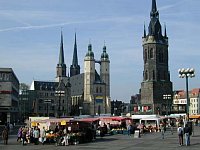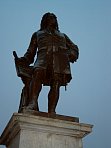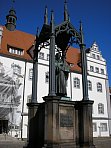City Halle and the University Halle
Halle (Saale)

marketplace of Halle
Halle (Saale) is located about 150 km south west of Berlin and 30 km west of Leipzig. It is the 3rd largest city (population 230000) in the new states of Germany (except Berlin, after Leipzig and Dresden). Halle celebrated its 1200th anniversary in 2006. The city got well-known by its saltern and by the fraternity of the Halloren. The most famous son of Halle is probably Georg Friedrich Händel . He was born in Halle and spent parts of his life here. Honouring him, the city celebrates an annual music festival. Another famous son of the city is August Hermann Francke. In 1698 he build the Franckeschen Stiftungen (Charite of Francke) a school including accommodation for children of lower class citizens. The buildings where recently restored. For mathematicians and computer scientists, Halle is probably well-known because Georg Cantor invented the set theory while he was professor for mathematics in Halle (actually he is the most famous ancestor of our departement).

Halle has a well preserved city center which was not destroyed in the World War II. The center was originally built in the 16th century and is surrounded by quarters from the Wilhelminian epoche. After the reunification, the people began to restore the city. The restoration of the city center is almost complete while the restoration of Wilhelminian buildings is still going on. Further objects of interest are the Moritzburg, the residence of Cardinal Albrecht of Brandenburg, the castle of Giebichenstein where now the University of Arts resides, the Saline Museum (german website) with demonstrations of saltern etc.
The region around Halle has lots of attractions. Within the distance of about 80 km there are four UNESCO world-heritages: The Bauhaus in Dessau is famous for its architectural style, the Luther memorials in Wittenberg (the city where Luther announced his 95 theses) and Eisleben (his place of birth), the Gartenreich Dessau-Wörlitz (german website) with the park of Wörlitz , the largest English landscape garden in continental Europe, and the old town of Quedlinburg , the largest preserved city center of the middle ages in Germany. The highest mountain in Northern Germany, the Brocken (elevation 1150 m) is located around 100 km west of Halle. It belongs to the Harz, a mountain region that starts about 30 km west of Halle. The most northern vine region in Germany is the Saale-Unstrut region south of Halle.
Martin-Luther-University Halle-Wittenberg

The Martin-Luther-University Halle-Wittenberg has two ancestors, the University of Wittenberg and the University of Halle. The University of Wittenberg was founded 1502 and is therefore among the oldest German universities. Our university is named after the probably most famous professor at the University of Wittenberg, Martin Luther. The University of Halle was founded 1694 by Duke Friedrich III. Within a few years the University of Halle was the leading university of the German Enlightment and the Pietism. After the Vienna Congress, the two universities where united in 1817. Today, the academic life takes place in Halle, the part in Wittenberg is a small conference center (unfortunately too small for ECOWS 2007). At the day of the reformation (October 31), there is an annual disputation on current themes and the deans, the academic senate, the vice presidents, the chancellor, and the president of the university move in historic robes from the town hall of Wittenberg to the Leucorea (the Wittenberg part of our university) through the historic city center of Wittenberg .
As already mentioned, for mathematicians and computer scientists, Georg Cantor acted at the department of mathematics of our University. He invented the set theory while he was professor in Halle. Currently the local opera house staged an opera Georg Cantor in his honor.
The university currently has about 17,000 students. It has nine faculties: three faculties for natural sciences, three philosophical faculties, a faculty for economics and law, a theological faculty, and a medical faculty. The institute of computer science belongs to the Faculty of Natural Science III.



